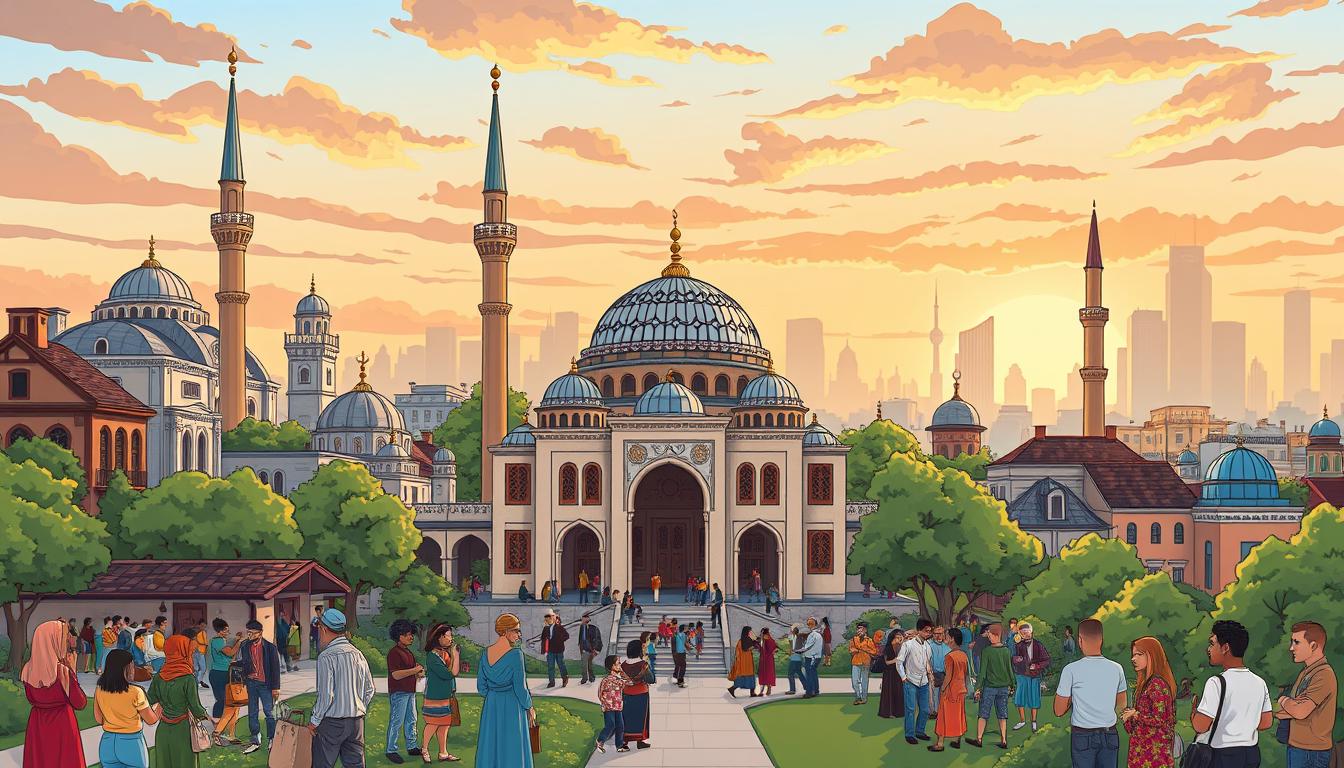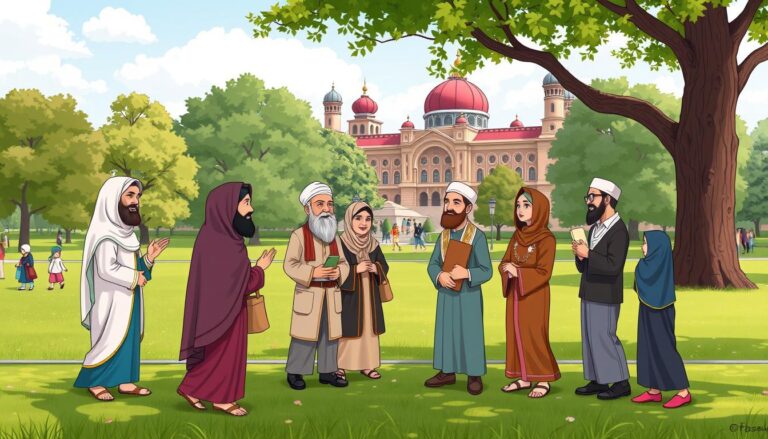Islam in America
Did you know that Islam is the third-largest religion in the United States, with an estimated 1.1% of the population (or 3,450,000 people) identifying as Muslim? This diverse and growing community has a rich history in America, dating back to the arrival of enslaved Muslims from West Africa during the Atlantic slave trade. Over the past few decades, the Muslim population has expanded significantly, with immigrants and their descendants now making up around 72% of all American Muslims.
Key Takeaways
- Islam is the third-largest religion in the US, with an estimated 3.45 million Muslims making up around 1.1% of the population.
- The first Muslims in America were enslaved West Africans, with an estimated 10-20% of slaves being Muslim.
- After the 1965 Immigration Act, the Muslim population grew rapidly, with immigrants and their descendants now comprising 72% of American Muslims.
- Muslims in America come from diverse ethnic and racial backgrounds, with no single group making up a majority.
- The Muslim community in the US continues to face challenges such as discrimination and Islamophobia, but also plays an increasingly important role in American society.
The Diverse Landscape of Muslim Americans
The Muslim American community is a tapestry of diverse ethnic and racial backgrounds, reflecting the global nature of the Islamic faith. According to a 2017 study, there is no majority race among American Muslims, with 26% identifying as white, 18% as Asian, 18% as Arab, 9% as black, 7% as mixed race, and 5% as Hispanic. This rich diversity is a testament to the inclusivity and universality of Islam.
The Pew Research Center estimates that around 73% of American Muslims are Sunni and 16% are Shia, with the remainder identifying with other movements such as the Nation of Islam or Ahmadiyya. This pluralism within the Muslim American community reflects the global landscape of the faith, where various denominations and traditions coexist.
Ethnic and Racial Diversity
The demographics of the Muslim population in America are a mosaic of different ethnicities and races. Racial diversity of Muslim Americans, Ethnic backgrounds of US Muslims, and Demographics of Muslim population in America all contribute to the unique character of this community.
- According to a 2017 study, American Muslims have no majority race, with 26% identifying as white, 18% as Asian, 18% as Arab, 9% as black, 7% as mixed race, and 5% as Hispanic.
- The Pew Research Center estimates that around 73% of American Muslims are Sunni and 16% are Shia, with the remainder identifying with other movements.
- This diversity is a reflection of the global nature of the Islamic faith, which has adherents from a wide range of cultural and ethnic backgrounds.
“The diversity of the Muslim American community is a reflection of the global nature of the religion.”
Historical Roots and Early Muslim Presence
The history of Islam in America can be traced back to the 16th century, when African slaves brought to the United States included a significant population of Muslims, estimated to be between 15-30% of the enslaved community. While many were forcibly converted to Christianity, some were able to maintain their religious practices and identities despite the challenging circumstances.
In the mid-17th century, Ottoman Muslims are documented to have immigrated to the US, and the late 19th and early 20th centuries saw a substantial influx of Muslim immigrants from the Balkans, Syria, and other parts of the Ottoman Empire and British India. These early Muslim communities established some of the first mosques and Islamic institutions in the country.
During the Revolutionary War (1775–1783), Muslims fought alongside colonial troops, with records indicating men of Muslim names on military muster rolls. Thomas Jefferson, a founding father, even included Islam in his early writings and political treatises, advocating for religious freedom for Muslims.
Enslaved Muslims used their literacy in Arabic to resist slavery and communicate, strategically using the language to convey messages against their captivity. Some, like Yarrow Mamout, were able to leverage their skills in areas such as bookkeeping to gain their freedom.
“Traces of Islam brought to America by enslaved Africans are still visible in practices like the ring shout, originating from Muslim rituals.”
Despite the hardships faced, enslaved Muslims formed networks and communities, maintaining their religious identity through challenging circumstances. Material culture left behind, including books, writings, clothing, and rugs, serves as a reminder of their presence and religious practices.
The 19th century saw the emergence of prominent African-American Muslims, such as Bilali and Al Haj Omar Ibn Said, who left behind written accounts of their lives and faith. This rich history continues to shape the diverse landscape of Muslim Americans today.
Immigration Waves and Population Growth
The Muslim population in the US has experienced remarkable growth over the past few decades, thanks to successive waves of immigration, particularly from the Middle East and South Asia. After the passage of the Immigration and Nationality Act of 1965, which abolished previous immigration quotas, the number of Muslims coming to the US increased dramatically.
In 2005, nearly 96,000 people from Muslim-majority countries became legal permanent residents of the US, the highest number in any year during the previous two decades. The Pew Research Center estimates that South Asia and the Middle East-North Africa region are the largest sources of Muslim immigrants to the US.
From the Middle East and South Asia
According to the available data, the Muslim population in America has grown significantly over the years. Experts estimate that between four and seven million Americans practice the Islamic faith, and it is anticipated that Islam will become the second-largest religion in the country.
- Estimated number of Muslims in the United States varies: American Muslim Council claims 5 million, while the Center for Immigration Studies suggests closer to 3 to 4 million followers of Islam.
- The American Religious Identification Study by the City University of New York reported approximately 1,104,000 Muslims in 2001.
- Over 1500 Islamic centers and mosques exist across the United States.
“Prejudice against Muslims has increased significantly since the 9/11 attacks, prompting many Muslims to engage more actively in the American political process.”
The growth of the Muslim population in America has been a significant demographic shift, with the number of Muslim Americans expected to continue rising in the coming decades. As the community becomes more integrated into the fabric of American society, it will be important to address issues of discrimination and promote greater understanding and acceptance.
Geographical Distribution and Centers
The Muslim population in the United States is geographically diverse, with concentrations in various regions across the country. Some states, particularly in the South and Midwest, report Islam as the largest non-Christian religion. Over the years, Muslim communities have established numerous Islamic centers and mosques, with an estimated 1,500 such facilities nationwide.
The major Muslim communities in America are primarily located in urban centers like New York, Los Angeles, Chicago, and Detroit. However, smaller Muslim population distribution in the US can also be found in states such as Michigan, Ohio, and the Dakotas. These communities have played a vital role in shaping the cultural and religious landscape of their respective regions.
“Islam is the fastest-growing religion in the United States, with more than 3.45 million Muslims of all ages living in the country as of 2017, according to a new estimate by the Pew Research Center.”
The diversity of the Muslim population distribution in the US reflects the broader ethnic and cultural makeup of the American Muslim community. As these communities continue to grow and thrive, they contribute to the rich tapestry of the nation’s religious and cultural heritage.
Islam in America
Islam has been a part of the American landscape for centuries, with the earliest documented presence dating back to the 16th century. Over time, Muslim Americans have made significant contributions to various aspects of American society, including politics, academia, sports, and popular culture. Notable figures like Malcolm X and Muhammad Ali have brought increased public prominence to the Muslim community.
Today, there are estimated to be between 3.5 to 4.5 million Muslims in the US, and Islam is predicted to eventually become the second-largest religion in the country. Immigrant families are a significant driving force behind the rapid growth of Islam in the United States, with about 58% of American Muslims coming from more than 70 different countries.
Despite the influence of Muslim Americans, incidents of anti-Muslim assaults have been on the rise in the United States. Several notable educational institutions, including Stanford, the University of Maryland, Columbia, and Harvard, have adopted anti-Islamophobia measures to combat this trend. The White House has also hosted annual community iftar meals, with all presidents since Bill Clinton following suit, as a gesture of the role of Islam in American society.
“Thousands attended the funeral of Palestinian American child Wadea Al-Fayoume, which turned into a Free Palestine rally.”
Muslim American organizations have also engaged in cultural and attitudinal projects following 9/11 to combat misconceptions about their communities. However, fissures within the Muslim and Arab communities around support for Biden are showing signs of closing, as they increasingly unify in demanding a shift in U.S. Middle East policy.
Despite these challenges, Muslim Americans continue to make their mark on the country, contributing to the diversity and richness of American society. As the community grows and evolves, their role and influence in American society are sure to continue expanding.
Generational Dynamics and Integration
The Muslim American community is a diverse tapestry, with around 58% of Muslim adults being first-generation immigrants, 18% being second-generation, and 24% being U.S. natives with U.S.-born parents. This generational mix has led to varying levels of integration and perspectives within the community.
Navigating Generational Differences
For instance, U.S.-born black Muslims are more likely to be converts to Islam and express concerns about discrimination compared to other Muslim Americans. Meanwhile, immigrant Muslims tend to have better socioeconomic standing and exhibit more positive opinions about their place in America.
Interestingly, second-generation Muslims are predominantly white (52%) or have at least one parent from the Middle East or North Africa (44%). In the third generation or higher, 51% identify as black, with very few being Asian, and two-thirds are converts.
Regardless of their generational status, Muslim Americans continue to navigate the process of integration, seeking to maintain their religious and cultural identity while becoming part of the American mainstream.
“Immigrant and U.S.-born Muslims have similar levels of religious observance, pride in their religious and national identities, as well as rates of attendance at religious services and adherence to religious practices.”
The diversity within the Muslim American community is a testament to the resilience and adaptability of the faith. As successive generations continue to integrate, the community’s unique perspectives and experiences will undoubtedly shape the ever-evolving landscape of Islam in America.
Educational Attainment and Economic Status
Muslim Americans have made significant strides in educational attainment, closely mirroring the general public. According to the latest data, around 31% of Muslim adults hold a college degree, including 11% with a postgraduate degree. However, the educational landscape exhibits some disparities, as immigrant Muslims tend to be more highly educated than their U.S.-born counterparts.
When it comes to economic status, the Muslim community in America reflects a mixed picture. They are about as likely as other Americans to have a household income exceeding $100,000. Yet, they are also more likely to have an income under $30,000, suggesting potential economic challenges faced by some segments of the community. The survey data also reveals that Muslims are three times more likely than other Americans to be without a job and actively seeking employment.
These findings underscore the diverse socioeconomic profile of the Muslim American population. While significant progress has been made in educational attainment, economic disparities within the community remain an area that requires further examination and targeted support.
“The Muslim American community represents a tapestry of educational and economic experiences, reflecting the nuanced reality of this vibrant and dynamic population.”
Age Distribution and Demographic Trends
The Muslim American community stands out for its youthful age profile, with demographic trends that differ significantly from the general U.S. population. Around 35% of Muslim American adults are between 18 and 29 years old, a much higher proportion compared to 21% in the overall U.S. adult population. Furthermore, 60% of Muslim American adults are between 18 and 39 years old, nearly double the 38% seen in the U.S. adult population as a whole.
This younger age profile is also reflected in the median age of Muslim adults in the U.S., which is 35 years old – significantly lower than the overall U.S. adult median age of 47. These demographic trends suggest a growing and evolving Muslim community in America, with a substantial proportion of young and middle-aged individuals shaping its present and future.
“The Muslim American adult population is considerably younger than the overall U.S. adult population, with around 35% being between 18 and 29 years old, compared to 21% in the general population.”
The age distribution and demographic shifts within the Muslim American community highlight the community’s dynamism and potential for continued growth and influence in the years to come. As the Muslim American population continues to evolve, understanding these demographic trends will be crucial for policymakers, community leaders, and the general public.
Religious Practices and Observance
The religious practices of Muslim Americans are diverse, reflecting the community’s rich tapestry of beliefs and traditions. According to the Pew Research Center, around 73% of American Muslims identify as Sunni, while 16% are Shia, with the remainder belonging to other Islamic movements or considering themselves non-denominational.
The diversity of Islamic observance among Muslim Americans is also evident in their daily lives. While the majority maintain their religious practices, the level of observance can vary across different generations and backgrounds. The role of religion in the Muslim community continues to be a vital aspect of their identity and culture.
- Four-in-ten Muslims in America attend religious services at least weekly.
- Approximately four-in-ten Muslim women always wear hijab in public.
- 65% of U.S. Muslims rate religion as “very important” in their lives.
- 80% of U.S. Muslims fast during Ramadan.
The strength of the Muslim American community’s religious commitment is further evident in the fact that around three-quarters of them express satisfaction with the quality of available mosques. This highlights the central role that religious institutions play in the lives of many Muslim Americans.
“The diversity of Islamic observance among Muslim Americans is also evident in their daily lives.”
While the majority of Muslim Americans maintain their religious practices, the level of observance can vary. For instance, 42% of Muslims in America pray all five daily salah, while one-in-five do not fast during Ramadan. Additionally, 52% of U.S. Muslims believe that Islam’s teachings need to be reinterpreted to address modern issues, showcasing the nuanced and evolving nature of religious observance within the community.
Challenges and Opportunities
Despite the growth and diversity of the Muslim American community, they continue to face significant challenges, including discrimination and Islamophobia. Studies have shown that American-born black Muslims are more likely to report experiencing discrimination and perceiving conflict between Islamic teachings and democracy.
In response to these challenges, many Muslims have become more active in the political process and have worked to educate their fellow Americans about their religion and heritage. The Muslim community continues to navigate these obstacles while exploring opportunities for greater representation and integration within American society.
Discrimination and Islamophobia
According to recent surveys, nearly half of Muslim Americans have reported experiencing at least one incident of discrimination in the past 12 months, and approximately one-third expressed concerns about the government monitoring their phone calls and emails due to their religion. Additionally, a small percentage of U.S. Muslims reported being physically threatened or attacked in the past year because of their faith.
Despite these challenges, the Muslim community has demonstrated resilience and a commitment to advocating for their civil rights. Many have become actively involved in political and civic activities, working to build bridges and foster understanding between Muslims and their fellow Americans.
“Approximately half of Muslim Americans stated that it has become harder to be Muslim in the U.S. recently, and 48% reported experiencing at least one incident of discrimination in the past 12 months.”
The Muslim community’s efforts to address discrimination and Islamophobia have been critical in promoting mutual understanding and creating a more inclusive society. Through education, advocacy, and political engagement, they continue to navigate the challenges they face while exploring new opportunities for growth and integration.
Conclusion
The story of Islam in America is one of diversity, resilience, and the ongoing pursuit of belonging. From the arrival of enslaved Muslims in the 16th century to the significant growth of the Muslim American community in the latter half of the 20th century, the presence of Islam in the United States has been both longstanding and multifaceted. Today, the Muslim population in the US is estimated to be between 3.5 to 4.5 million, with a rich tapestry of ethnic and racial backgrounds.
While the Muslim American community has made important contributions to American society, they continue to face challenges such as discrimination and Islamophobia. However, the community remains steadfast, working to overcome these obstacles and shape their place within the broader fabric of the United States. As the future of Islam in America unfolds, the summary of key points reveals a story of resilience, integration, and the future of Islam in America that holds both promise and complexity.
As the Conclusion of this exploration, it is clear that the Muslim American experience is one that deserves nuanced understanding and active engagement. The path forward will require ongoing efforts to bridge divides, foster understanding, and celebrate the richness that the Muslim American community brings to the United States.
Source Links
- Religion in American History, TeacherServe, National Humanities Center
- The US city run by Muslim Americans
- Islam in the Americas
- 2. Identity, assimilation and community
- The truth about Muslims in America | CNN
- New study shows Muslim-Americans as vibrant contributors to American philanthropy
- African Muslims in Early America
- The First American Muslims
- Islam In America | History Detectives
- Muslims projected to be second-largest U.S. religious group by 2040
- Religious Landscape Study
- Islam and Western Culture
- There is a seismic shift in the Muslim American community
- Islam in America
- Muslims in America: Immigrants and those born in U.S. see life differently in many ways
- Islam, the American way
- Contexts of Reception and Constructions of Islam: Second Generation Muslim Immigrants in Post-9/11 America
- 1. Muslim educational attainment
- Muslims in the United States
- 1. Demographic portrait of Muslim Americans
- Islam in the United States
- Section 1: A Demographic Portrait of Muslim Americans
- Religious Discrimination
- 6. Religious beliefs and practices
- What You Should Know: Workplace Religious Accommodation
- Muslim Americans and cultural challenges: Research roundup
- U.S. Muslims Concerned About Their Place in Society, but Continue to Believe in the American Dream
- How Americans View Muslims—And What They Don’t See
- Prejudice toward Muslims is highest among all religious and ethnic groups
- Should "Islam" matter in US foreign policy?







